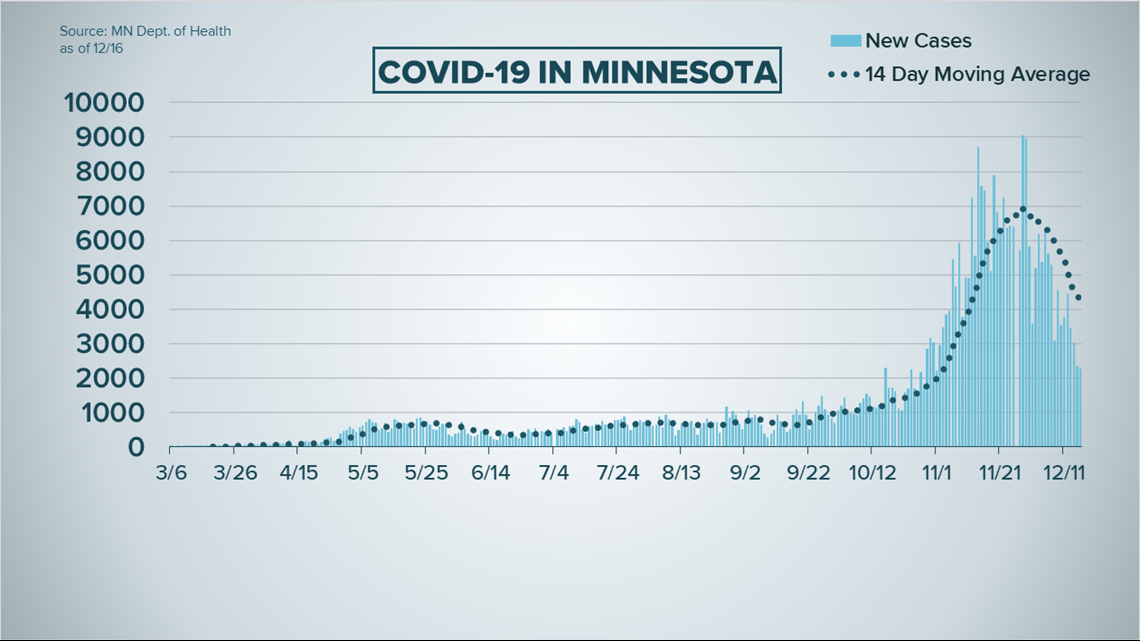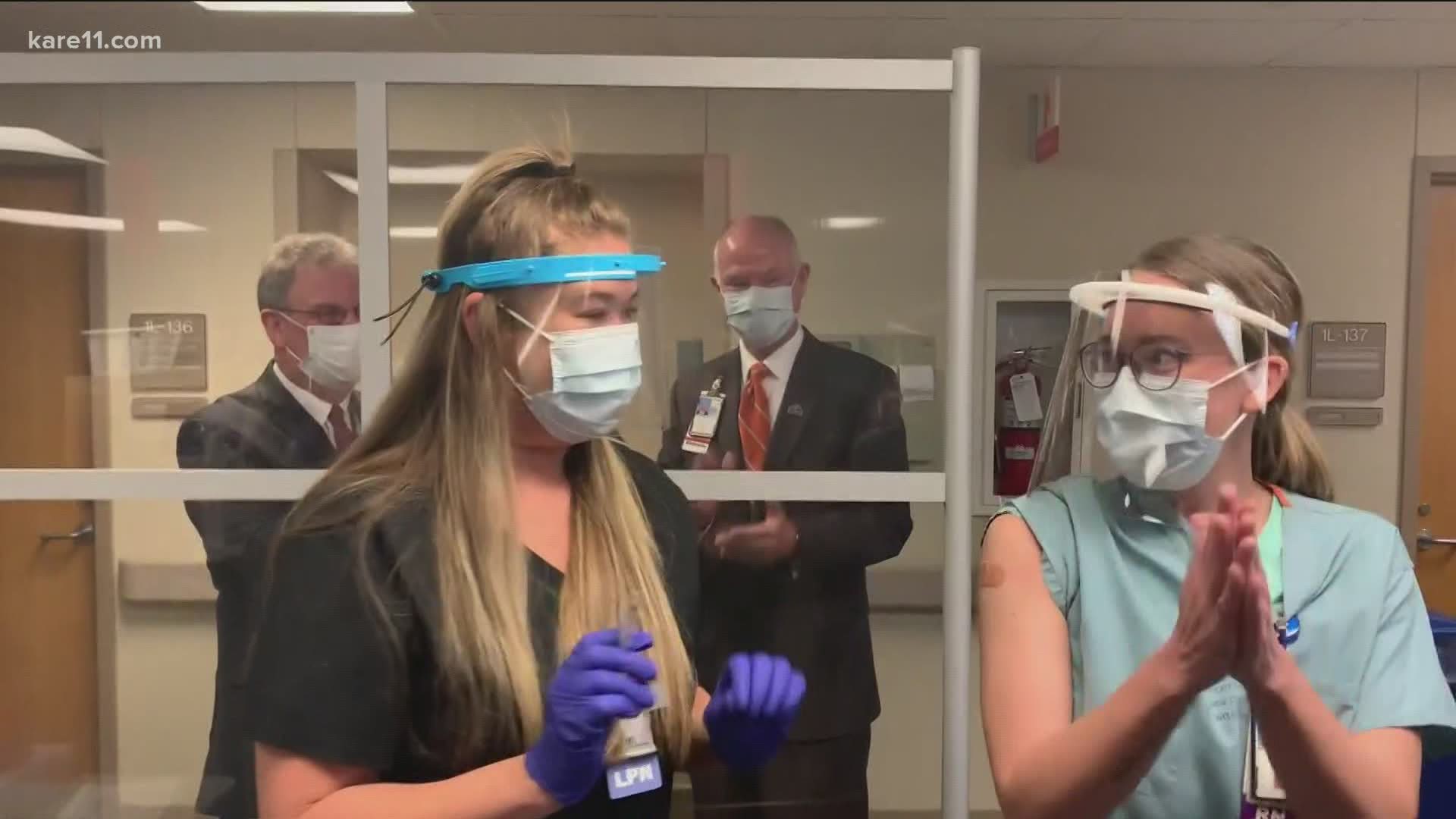Wednesday, Dec. 16
- Gov. Walz to make 1:15 p.m. announcement on changing COVID-19 restrictions, ongoing pause on indoor dining
- Negotiators are nearing an agreement on a second stimulus check in federal aid bill
- Minnesota prepares to begin administering COVID-19 vaccine, next batch to arrive at the end of the week
- COVID-19 cases trending down across state, deaths spike again
2:15 p.m.
On Wednesday afternoon, Gov. Tim Walz took questions from the media after announcing his planned modified restrictions for Minnesota. He also signed into law a bill that will give relief to small businesses impacted by his "pause," and extend unemployment benefits.
Walz said this legislation was the result of "true compromise," and thanked House and Senate leaders from both sides of the aisle.
After signing the bill, Walz pivoted to discussing the new COVID-19 guidelines in Minnesota.
He acknowledged the group of restaurants in Minnesota that plan to reopen despite the continued restrictions on indoor dining, and said that the state will handle those instances on a case-by-case basis. He added that it is no one's intention to arrest anyone.
Though cases and hospitalizations have been decreasing, Walz said that Minnesota's number went from "really horrendous" to "just horrendous."
"We can single out the things where we get the biggest bang for the buck, if you will, on the mitigation efforts," he said. "Specifically bars and restaurants, where we can get transmission rates lower and start to bring that back down."
Walz added that he believes numbers could rise again, but these mitigation efforts could help prevent that in the future.
When asked about reactions from industries that say the data provided from the state does not warrant further restrictions, Minnesota Department of Health (MDH) Commissioner Jan Malcolm said that the disagreement tends to come when people are looking only at primary cases coming from, for instance, known bar and restaurant outbreaks.
She explained that those primary transmissions might not be very high, but the problem arises when primary transmissions in these indoor locations lead to widespread secondary transmission. According to Malcolm, one primary case can lead to 70 cases after four generations of transmission.
"In a forest fire it's very hard to find the hot spot when everything's on fire," she said. "So these data arguments just get harder and harder to satisfy people, but the macro level data about the risks of certain environments are certainly quite compelling, we think, and consistent."
Walz addressed that some families may be training, traveling or playing youth sports in other states.
"I can't dictate or enforce to everybody," he said. "What I do know is if you choose to do that, you're putting your family and others at risk. I don't think that makes you a bad person, I think it makes you a good parent. But if you choose to do these things, that's how we got into this situation as a country. Traveling out of state for sports activities specifically to avoid, or going to states that don't have mitigation in place, is risky."
He also said he is advocating for more testing in elementary schools to help students get back to in-person learning, and that the state plans to provide that testing capacity to schools.
Walz emphasized that he knows following these restrictions can be frustrating, but that Minnesotans deserve to have their leadership tell them what they need to hear, not what they want to hear.
"This isn't us versus an industry," he said. "This isn't parsing a number to try and get to a certain place, this is a global pandemic against a killer virus that we've learned much about and have a lot of tools to fight, but we've got a little left to fight. That sun is rising. This will be the week of the longest, darkest nights; next week starts moving toward spring."
1 p.m.
Gov. Tim Walz is expected to give a live address to Minnesotans at 1:15 p.m. giving details on changing restrictions for the holidays. KARE 11 will broadcast that announcement live on the air, on KARE11.com and on the KARE 11 YouTube page.
The modified restrictions, which include more in-person learning options for elementary students, limited outdoor dining for restaurants, limited social gatherings and gyms opening at 25% capacity, were spelled out in a news release Wednesday.
11 a.m.
After dropping down considerably for two days in a row, deaths from COVID-19 in Minnesota have shot back up.
The Minnesota Department of Health (MDH) reported 92 deaths on Wednesday, up from 21 reported Tuesday and 18 on Monday. Prior to Monday, deaths were substantially higher for five days, with an average of 83 per day.
Ninety-two deaths is the third-highest daily total so far in Minnesota, and was matched on Dec. 3. The state hit 94 on Dec. 11, and a record 101 on Nov. 27.
New COVID cases diagnosed in Minnesota continue to trend downward, with 2,279 reported by MDH on Wednesday. That number includes 2,033 cases diagnosed by PCR test, considered "confirmed," and 246 "probable" cases from antigen tests. The new cases reported Wednesday represent the lowest single-day total since Nov. 1.


Testing in the past 24-hour period was down from prior days, with 19,644 tests performed across the state. that number has been above 30,000 and often past the 40,000 and 50,000 mark over the past week.
COVID-19 hospital use continues to trend generally downward in Minnesota, although ICU bed use went up slightly on Tuesday, the most recent data available.
On Monday 300 ICU beds were in use across the state, and that number went up to 304 on Tuesday. However, general non-ICU bed use went from 1,009 on Monday to 973 on Tuesday.
Twin Cities metro non-ICU beds are the most limited in the state right now, with only 130 beds, or 3.5% of capacity, available. Metro intensive care units are less full, with 48 beds, or 7% available.
Tuesday, Dec. 15
2 p.m.
MDH Infectious Disease Director Kris Ehresmann said that this week will be focused on educating health care providers on how to administer the COVID vaccine, which will coincide with the arrival of the next batch of vaccines for the state at the end of the week. Ehresmann noted that vaccines have already begun being administered in the state.
The current vaccine being used is the Pfizer vaccine but the Moderna vaccine is expected to get emergency approval from the FDA this week, Ehresmann said.
Providers are set to receive a higher number of Moderna vaccine doses once it is approved compared to the Pfizer vaccine.
11 a.m.
COVID-19 cases and deaths across Minnesota continued to trend downward on Tuesday, though testing numbers also dropped throughout the state.
The Minnesota Department of Health says an additional 2,340 cases of coronavirus were added to state totals over the past day, based on results from 32,117 tests (30,811 PCR, 1,306 Antigen) processed in private and state labs. Health officials consider a positive PCR test a confirmed case of COVID-19, while a positive Antigen test is labeled a probable case.
Those testing numbers are a significant decrease from the 45,341 reported tests on Monday.
The new positives bring Minnesota's total cases of the virus to 384,164 since the pandemic arrived. Of those cases, 10,672 are based on Antigen tests.
An additional 21 deaths from the virus were reported in the past 24 hours. Tuesday's reported deaths bring the total in Minnesota to 4,483 since the onset of the pandemic.
Total hospitalizations since the start of the pandemic have now reached 19,785, with 4,286 of those patients requiring ICU care.
Currently, 1,009 beds in hospitals across the state are being used to treat COVID patients, a number that is gradually decreasing. 300 people are also in the ICU, for a total of 1,309 patients being treated for the virus throughout Minnesota.
In the Twin Cities, non-ICU bed availability is improving, with 4.9% of beds open on Tuesday. However, the number of available ICU beds in the metro dropped slightly, with only 7% currently open.
Young adults make up the largest number of COVID cases in Minnesota, with 20 to 24-year-olds accounting for 39,657 cases and three deaths, followed by those 25 to 29 with 34,613 cases and five deaths. People 30 to 34 have recorded 32,002 cases with nine deaths.
The largest grouping of fatalities involves those ages 85 to 89, with 837 deaths in just 5,035 cases.
Hennepin County reports the most COVID activity in the state with 80,287 cases and 1,252 deaths, followed by Ramsey County with 34,300 cases and 593 deaths, Dakota County with 27,615 cases and 237 deaths, and Anoka County with 27,003 cases and 265 fatalities.
Cook County in northeastern Minnesota reports the least COVID activity with 97 cases and zero deaths.
KARE 11’s coverage of the coronavirus is rooted in Facts, not Fear. Visit kare11.com/coronavirus for comprehensive coverage. Have a question? Text it to us at 763-797-7215. And get the latest coronavirus updates sent right to your inbox every morning. Subscribe to the KARE 11 Sunrise newsletter here. Help local families in need: www.kare11.com/give11.
The state of Minnesota has set up a data portal online at mn.gov/covid19.

